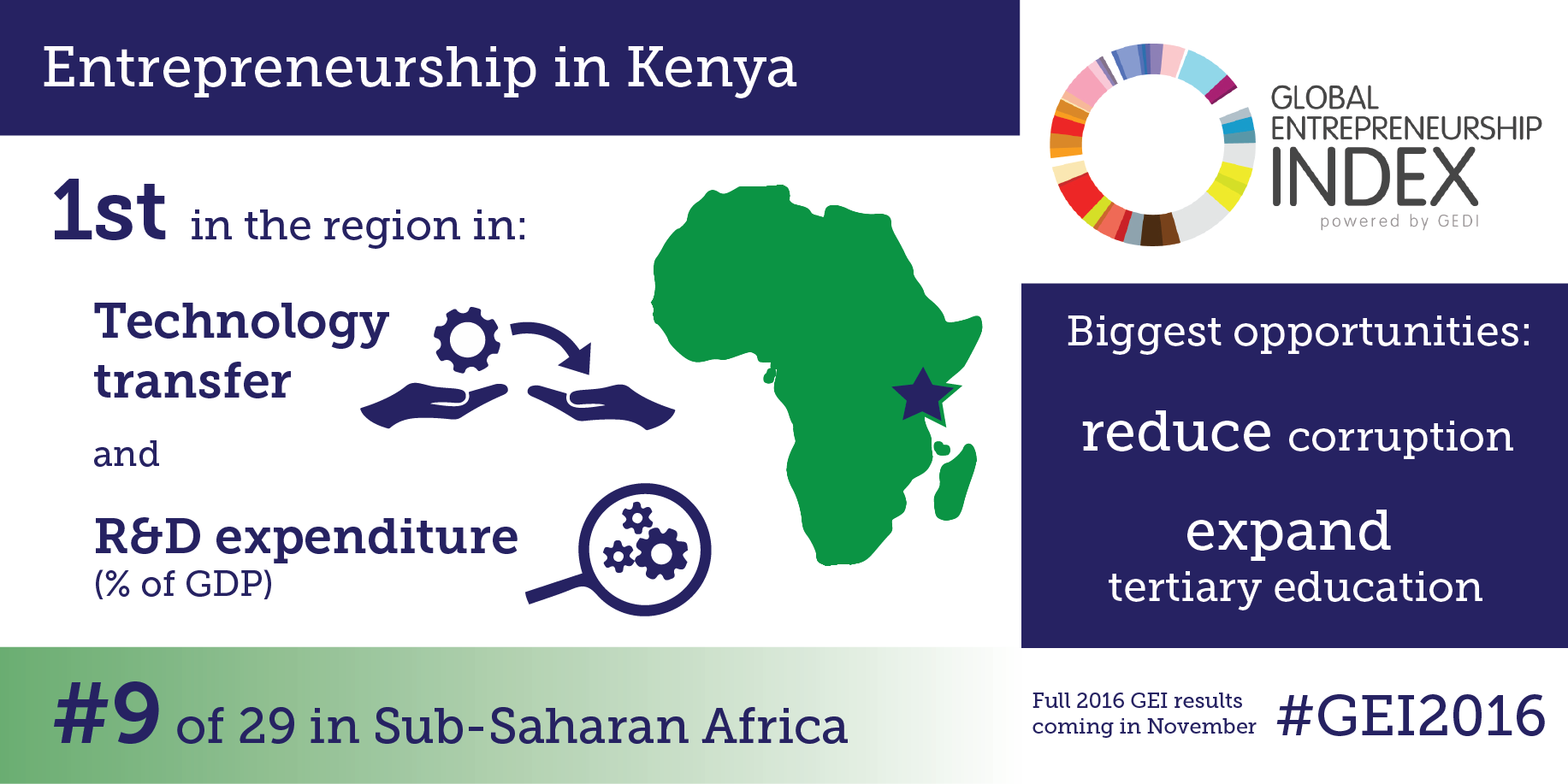A special co-authored post from Zoltan Acs and Jonathan Ortmans
The patterns of ‘lightning’ speed development that we witnessed in China are starting to appear in the skies over Kenya. The development of institutions that support entrepreneurship across the Sub-Saharan African region follows a similar pattern to that of China ten years ago.
That is one of the reasons the U.S. government selected Nairobi to host the 2016 Global Entrepreneurship Summit and President Barack Obama personally traveled there to help lift up nascent African entrepreneurs. To begin to explore the entrepreneurial ecosystem in the region, we are pleased to feature a special preview of the 2016 Global Entrepreneurship Index results for Kenya—with new information on key strengths and weaknesses for the country.
The Global Entrepreneurship Index provides a detailed look at the entrepreneurial ecosystem of 132 nations by combining individual data with institutional components. This composite index gives policymakers a tool for understanding the entrepreneurial strengths and weaknesses of their countries’ economies, enabling them to implement policies that foster productive entrepreneurship.
Since last year, Kenya has shown improvements in technology absorption and business strategy – an indication that Kenyan businesses are adopting new technology and improving business practices. This trend could continue if Kenya keeps scoring well in its two top areas: R&D expenditure and technology transfer, as activities in these areas feed into tech absorption and business strategy.
First some quick data:
- Kenya is first in the Sub-Saharan Africa region (29 countries) in two of thirty indicators: Technology transfer and Gross expenditure on research and development (GERD)
- Its performance in Tech transfer and GERD is far above the regional average.
- Kenya is ninth of 29 in the region for overall GEI despite being 13th in the region for GDP
- However, Kenya is 23rd in the region in Tertiary Education, and 26th in the region in Corruption
- Its overall GEI score is 22.1 out of 100
How do we interpret these results?
When it comes to attitudes, Kenyans as individuals do well, but the institutions need to catch up. Kenya has very confident potential entrepreneurs that are seeing opportunities around them to start businesses, and have networks of other entrepreneurs to look to, while external factors like the risk climate, education and market structure are lagging behind and very likely holding them back.
When we look at growth and scaling we see somewhat the opposite occurring – Kenya does well in technology transfer, has low levels of monopolization in markets, and invests in research and development at a rate above its GDP level, but entrepreneurs are not necessarily taking full advantage of those conditions.
Kenya vs. South Africa
Kenya can look to South Africa, the region’s highest scorer, for best practices.
On average, over the past twelve years of data, South Africa has been improving its GEI score by .6 points per year, going from 31.9 in 2002 to 38.7 in the most recent year. That’s an increase of 21 percent. These improvements have been primarily due to increases in internet usage, informal investment, and technology transfer.
GDP per capita has increased by 26 percent (2002-2014) over the same period. This is one indication that conditions for entrepreneurship in countries like South Africa have been steadily improving.
Kenya’s entrepreneurship imperative
Kenya will need to create over 3.9 million new jobs for young people by 2020, an estimate based on its projected population growth.
When we start to look at Kenya’s biggest opportunities for improvement revealed through the GEI, corruption and tertiary education offer “low hanging fruit”. The path forward becomes clear: if the country can reduce corruption and improve tertiary education rates its entrepreneurs will be better prepared to capitalize on the advantages revealed in the pillars that conform the Global Entrepreneurship Index, particularly the country’s institutional advantages in technology transfer and research and development. If more Kenyans are better educated, and they face fewer barriers (corruption), they will be more likely to look to innovate in areas where low monopolization provides an opportunity for growth.
The Global Entrepreneurship Index, while by no means the definitive answer, seeks to shed light on the efficiency of national startup ecosystems through analysis of 34 essential individual and institutional variables. It attempts to reveal the bottlenecks that erode hard-won competitive advantages for national entrepreneurship ecosystems.
The full 2016 Global Entrepreneurship Index, featuring fresh analysis on 132 countries, will be released during Global Entrepreneurship Week in November.

